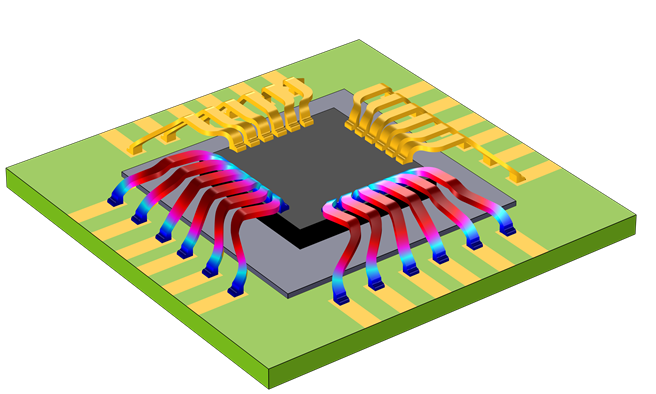
As part of our recurring video lectures, we posted a five-part course that covers the usage of the COMSOL Multiphysics® software for modeling Joule heating and thermal expansion. Over five parts, we provide a complete tutorial of how to get started in this area, and the series is a great resource for anyone interested in learning the software in general. Let’s review this course and point out some related resources as well.
Getting Started with Joule Heating and Thermal Expansion
Many common engineering problems involve Joule heating, the rise in temperature of a conductive material as current passes through it. We start off this course by introducing a relevant problem of interest, the heating of a set of bond wires connecting a chip to a circuit board. For this example, we concern ourselves solely with these bond wires.

Bond wires on a chip. As current passes through the wires due to an applied electric potential difference, there is Joule heating, which leads to a variation in temperature, and resultant structural expansion and thermal stresses.
Watch the Electro-Thermal-Mechanical Modeling course here.
Part 1
The first video begins by demonstrating how to import the CAD geometry of the chip. In this example, we work with a COMSOL native CAD file, although there are other options for working with CAD files.
Next, we set up the problem of computing the electric currents through the wire by applying a potential difference. From there, we examine the mesh and use virtual operations to remove some small geometry features to simplify the mesh, and then we solve and visualize the results.
Part 2
The second video builds upon the first. We use integration to extract numerical data from the model and investigate the mesh refinement of the model, a necessary part of building any finite element model. From there, we expand our model to solve for the temperature field within the bond wire. We use coordinate-based and Boolean selections to define the thermal boundary conditions that prescribe temperature and radiation, and also approximate free convection.
Part 3
In the third video, we introduce material nonlinearities by making both the electrical and the thermal conductivity functions of the temperature field. This can lead to some surprising results, which we discuss in more detail during the lecture. We also introduce some more options for electrical excitation and for evaluating the results.
Part 4
In the fourth video, we give an overview of the solver algorithms and how to interpret the information the software is reporting. We also discuss the limitations of the stationary assumption and when you should switch to a transient analysis and demonstrate how to compute the temperature rise over time. Lastly, we extend our model to include thermal expansion and discuss different solution approaches.
Part 5
Finally, in the fifth video, we continue modeling the deformation and also incorporate user-defined meshing, as well as adaptive mesh refinement, to gain confidence in our solution. From there, we move on to consider other geometries and also show how to present visually attractive results. Then, we turn the model file into a standalone application using the Application Builder.
Closing Remarks
The Electro-Thermal-Mechanical Modeling course is meant to provide not only an introduction to the topics of Joule heating and thermal expansion but also to give a thorough overview of the usage of the software, so it will be useful to anybody who is just getting started.
The example chosen here is quite similar to one of the examples we use in the Introduction to COMSOL Multiphysics user’s guide, which is another great resource if you prefer to follow a written approach as an introduction to the software. Once you’ve gone through this material, you will have a firm foundation in the usage of COMSOL Multiphysics and will be ready to tackle even more challenging topics!
Try It Yourself
The geometry files and the model files used during this course are available in the Learning Center course.




Comments (0)